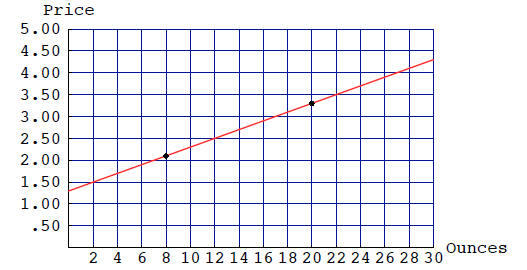Linear Equations and Graphing
Special forms for linear equations :
Slope- Intercept form .
Definition 4 An equation of the form
y = mx+b
is a linear equation in slope-intercept form.
Put 4x − 3y = 12 into slope- intercept form .
What are m and b?
What do they mean?
Price-demand equation: d = 1720 − .50p.
Put this into slope-intercept form.
What are m and b?
What is the meaning of m? of b?
In general, the graph of an equation y = mx + b defines a line
with slope m and y -intercept (0, b).
Special forms for linear equations : Point Slope
form.
Definition 5 An equation of the form
y − y1 = m(x − x1)
is a linear equation in point-slope form.
In general, the graph of an equation y − y1 = m(x − x1) is a line
with slope m passing through the point (x1, y1).
Example: What is the point-slope equation for the line with a
slope of 3 passing through the point (−4, 6)?
In this case m = 3 and (x1, y1) = (−4, 6). So the point-slope
form for the equation of the line is
y − 6 = 3(x+4).
The graph of an equation y −y1 = m(x−x1) is a line with slope
m passing through the point (x1, y1).
Example: Find an equation for the line passing through the
points (2, 1) and (5, 3).
To use the point-slope form for the line, we need to know one
point and the slope. In this problem the slope is not given, but
two points are known. To find the slope m, we use the fact that

So the point-slope form for the equation using (2, 1) as the point
is

If we use (5, 3) instead, then the point-slope form of the equation
is

These are two different equations for the same line.
Application: Depreciation.
Linear Depreciation. Office equipment was purchased for $20,000
and is assumed to have a scrap value of $2,000 after 10 years. If
its value is depreciated linearly (for tax purposes) from $20,000
to $2,000:
1. Find the linear equation that relates value (V) in dollars to
time (t) in years. (Hint: you know two points .)
1. Ans: V = −1800t + 20000. Write a verbal interpretation of
the slope of the line.
2. What would be the value of the equipment after 6 years?
3. Graph the equation V = −1800t+20000 for 
Application: Linear Interpolation
The price of a cup of coffee in a coffee bar depends on the size of
the cup. The 8-ounce cup costs $2.10, but the larger 20-ounce
cup costs $3.30. Without any other information, how could you
estimate the cost of a 10-ounce cup, or a 16-ounce cup?
Sometimes business people use a method known as linear interpolation.
This means that they assume that the price p of a
cup of coffee and the size q of the cup obey a linear equation.
So the graph of the linear equation is a line and we know two
points on this line: (q, p) = (8, 2.10), (20, 3.30).
Units: The price p of the cup of coffee is given in dollar.
Size q of the cup of coffee is given in ounces.
two points on the line: (q, p) = (8, 2.10), (20, 3.30).

Slope: We know that the price of an 8-ounce cup is $2.10 and
the price of a 20-ounce cup is $3.30. So the change in q is
$3.30−$2.10 = $1.20 and the change in p is 20oz.−8oz. = 12oz..
So the slope is:

Units for the slope m: dollars per ounce
Application: Linear Interpolation
Slope is $.10 per ounce.
How much does the price increase if the size of the cup increases
by 4 ounces?
Point-slope form: p − 2.10 = .10(q − 8)
Slope-intercept form: p = .10q +1.30.
y-intercept is $1.30.
Interpretation: The price of a cup of coffee is $1.30 plus ten
cents an ounce.
Slope-intercept form: p = .10q +1.30.
Use linear interpolation to find the price of a 12-ounce cup of
coffee:
| Prev | Next |